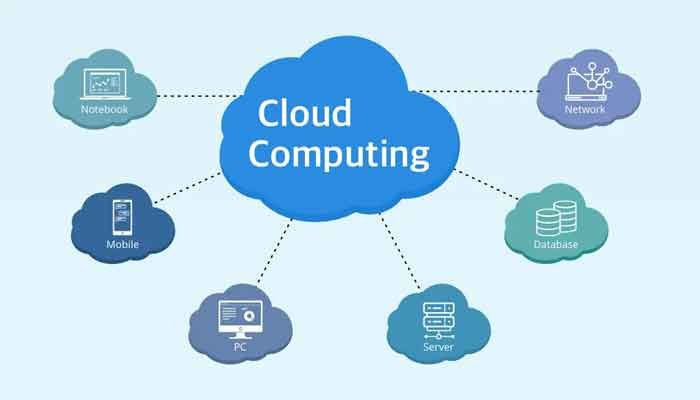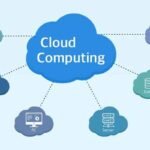What is Cloud Computing?
Cloud Computing Basics for Students begins with understanding what cloud computing really is. Cloud computing means using the internet to access computer services like storage, servers, databases, and software instead of using local computers or hardware. This lets students and users store data and run programs on powerful remote servers, called “the cloud.” The main idea is that users don’t need to own or manage physical machines.
For students, cloud computing basics help explain how their files, photos, and videos are saved on platforms like Google Drive or Dropbox. It also includes how apps like Google Docs work online without installing software on a computer.
Cloud computing basics for students include learning about the shared resources and fast access offered by the cloud. This allows students to work from anywhere, anytime, with just an internet connection. It also means less worry about losing data due to computer failure because cloud providers back up the data securely.
In summary, cloud computing basics for students cover the idea of using internet servers for computing needs. This saves money, improves flexibility, and supports modern learning tools. Knowing these basics will help students prepare for future technology use and jobs.
Why Cloud Computing is Important for Students
Cloud Computing Basics for Students is important because cloud computing changes how students learn and work. Students can access powerful tools without expensive equipment. This makes technology affordable and easy to use.
The main reason cloud computing basics for students matter is that they open many opportunities. Students can work on group projects online using cloud apps. They can save files in the cloud and access them from any device. This means no more losing work when moving between school, home, or mobile devices.
Also, cloud computing basics for students introduce them to skills in high demand. Many jobs today use cloud technology. Knowing cloud computing helps students prepare for careers in IT, software, data science, and more.
Moreover, cloud computing basics for students make learning flexible. Students can use virtual labs, online coding platforms, and cloud-based software anytime. It supports remote learning, which is vital in today’s education system.
In short, cloud computing basics for students offer affordable access to advanced tools, improve collaboration, and provide valuable skills. This makes cloud computing essential knowledge for modern students.
Read More: Understanding Computer Hardware Components in India
Main Features of Cloud Computing
Cloud Computing Basics for Students include understanding its key features. These features make cloud computing useful and powerful.
- On-Demand Access: Students can use cloud services whenever needed. No waiting for IT support.
- Scalability and Flexibility: Cloud resources grow with your needs. Use more storage or computing power as required.
- Cost Efficiency: Pay only for what you use. No need to buy expensive hardware or software licenses.
- Broad Network Access: Access cloud services from any device with internet. Laptop, tablet, or phone.
- Resource Pooling: Cloud providers share resources efficiently between many users.
- Rapid Elasticity: Quickly scale resources up or down.
- Measured Service: Cloud usage is monitored and billed based on consumption.
These features show why cloud computing basics for students are important to learn. They explain how cloud makes technology easy, affordable, and flexible.
Students who understand these features can better use cloud tools for projects and learning. It also helps them prepare for careers that rely on cloud technology.
Types of Cloud Computing Services
Cloud Computing Basics for Students include learning about the three main types of cloud services: IaaS, PaaS, and SaaS. These service models explain how cloud computing works and what it offers.
- Infrastructure as a Service (IaaS):
This service provides basic computing resources like virtual machines, storage, and networks. Students can rent servers and storage without buying physical hardware. IaaS is useful for learning about setting up networks or running software that requires heavy computing power. - Platform as a Service (PaaS):
PaaS offers a platform to develop, test, and deploy applications. It includes tools and software frameworks for programming. Students interested in coding and app development can use PaaS to build projects without worrying about underlying infrastructure. - Software as a Service (SaaS):
SaaS provides ready-to-use software applications online. Examples include Google Docs, Zoom, and Dropbox. Students use SaaS daily for writing, video calls, and file sharing without installing anything.
Understanding these service types is a key part of cloud computing basics for students. It shows how cloud computing adapts to different needs, from simple apps to complex software development.
By learning about IaaS, PaaS, and SaaS, students can pick the right cloud service for their studies or projects and gain valuable skills for future careers.
Cloud Deployment Models Explained
Cloud Computing Basics for Students also cover the different ways cloud services are deployed: public, private, and hybrid clouds. These models affect how data and applications are stored and managed.
- Public Cloud:
This cloud is open to anyone over the internet. Services like Google Cloud and AWS are public clouds. It is affordable and scalable but may have less control over data. - Private Cloud:
Private clouds are exclusive to one organization. They offer more security and control but are more expensive. Schools or companies might use private clouds for sensitive data. - Hybrid Cloud:
This model combines public and private clouds. It lets users keep important data in private clouds while using public clouds for less sensitive tasks. Hybrid clouds offer the best of both worlds.
Understanding deployment models is essential in cloud computing basics for students. It helps students know where their data lives and how cloud systems protect it.
Choosing the right deployment model depends on security needs, budget, and usage. This knowledge prepares students for real-world cloud decisions.
Popular Cloud Computing Platforms for Students
Cloud Computing Basics for Students include knowing popular cloud platforms that students can use for free or with student discounts. These platforms provide tools for learning and development.
- Google Cloud Platform (GCP):
GCP offers many cloud services like computing, storage, and AI tools. Google often provides free credits for students to try their services. - Amazon Web Services (AWS):
AWS is the largest cloud platform. It has extensive services from basic storage to machine learning. AWS Educate program offers free resources for students. - Microsoft Azure:
Azure provides a wide range of cloud services and integrates well with Microsoft Office tools. Azure for Students offers free access to cloud resources.
These platforms are essential in cloud computing basics for students because they offer real-world experience. Students can practice cloud computing skills, build projects, and prepare for certifications.
Exploring these platforms helps students understand cloud computing in practical ways and boosts their resumes for future job opportunities.
How Students Can Use Cloud Computing in Daily Life
Cloud Computing Basics for Students show that cloud technology is useful every day. Students can do many tasks easily with the cloud.
First, cloud storage and file sharing help students keep documents, photos, and videos safe online. Tools like Google Drive and Dropbox let students access files from any device, anytime. This means no lost homework or projects.
Second, online collaboration tools like Google Docs and Microsoft Teams allow students to work together in real time. Group projects become easier, even if members are far apart.
Third, students can use virtual labs and coding environments hosted on the cloud. This means they don’t need powerful computers to run software or write code. Cloud-based platforms like Replit or GitHub Codespaces make programming easy and accessible.
By understanding these uses, students learn practical parts of cloud computing basics for students. They get used to cloud tools that are common in schools and workplaces.
Using cloud computing daily builds important skills for students. It helps with organizing work, communicating with others, and learning technology that will be key in their careers.
Basic Cloud Computing Security Tips for Students
Cloud Computing Basics for Students must include learning about cloud security. Protecting personal data online is very important.
First, students should use strong and unique passwords for cloud accounts. This prevents unauthorized access.
Second, enabling two-factor authentication (2FA) adds an extra security layer. Even if a password is stolen, 2FA blocks hackers.
Third, students should be careful with what they upload to the cloud. Avoid sharing sensitive information unless sure the platform is secure.
Fourth, keep devices updated with the latest software to protect against malware and cyber threats.
Finally, understand privacy policies of cloud services. Know how data is stored and used.
These simple steps are part of cloud computing basics for students. They teach students how to stay safe while using cloud tools.
Good cloud security habits protect students’ data and build trust in cloud technology for the future.
Getting Started with Cloud Computing: Resources and Tutorials
Cloud Computing Basics for Students include knowing where to learn and practice cloud skills. Many free and paid resources help students start their cloud journey.
Some top places to learn are:
- Coursera and Udemy: Offer beginner courses on cloud computing.
- AWS Educate and Microsoft Learn: Provide free tutorials and labs with hands-on experience.
- Google Cloud Training: Includes free credits and courses for students.
- YouTube Channels: Many creators explain cloud concepts clearly.
Students can also try simple projects like creating a website or using cloud storage to practice.
Getting certifications like AWS Certified Cloud Practitioner or Microsoft Azure Fundamentals can boost resumes.
By using these resources, students gain real skills in cloud computing basics for students. This makes learning easy, fun, and practical.
Starting early helps students stand out in college applications and future job markets.
Future of Cloud Computing and Why Students Should Care
Cloud Computing Basics for Students show that cloud technology is growing fast and changing the world. Learning about future trends helps students stay ahead.
One big trend is Edge Computing, where data processing happens near the user instead of in distant servers. This makes apps faster and better for things like gaming and smart devices.
Another trend is Serverless Architecture. It lets developers run code without managing servers. This means less work and faster development.
AI and Cloud Integration is also important. Cloud platforms now offer artificial intelligence tools that help with data analysis, automation, and more. Students familiar with this will have an advantage.
Understanding these trends is part of cloud computing basics for students because it prepares them for careers in tech and beyond.
Cloud skills will be needed in many jobs, not just IT. Healthcare, finance, education, and entertainment use cloud tech daily.
Students who learn cloud computing now will have better career chances and can help shape future technology.
Conclusion:
Cloud Computing Basics for Students is a must-know topic for anyone in today’s digital world. It explains how cloud technology works and why it is important for learning and careers.
By understanding cloud computing basics for students, learners get access to flexible tools that make studying easier. They can work anywhere, collaborate smoothly, and protect their data.
Students who know cloud computing can explore real cloud platforms like AWS, Google Cloud, and Microsoft Azure. This builds skills that employers want.
Learning about cloud service types, deployment models, and security helps students use the cloud safely and effectively.
Finally, keeping up with future trends like edge computing and AI integration will keep students competitive in the job market.
In short, cloud computing basics for students open many doors. Starting now means a brighter future with endless opportunities in technology.
FAQs: About Cloud Computing Basics for Students
What is cloud computing in simple terms?
Cloud computing means using the internet to access storage, software, and servers instead of your local device.
Why should students learn cloud computing?
It helps students access powerful tools, work from anywhere, collaborate, and gain skills for future jobs.
What are the main types of cloud computing services?
They are Infrastructure as a Service (IaaS), Platform as a Service (PaaS), and Software as a Service (SaaS).
How secure is cloud computing for students?
Cloud services use strong security, but students should use strong passwords and two-factor authentication for safety.
How can students start learning cloud computing?
Students can use free online courses, tutorials, cloud platforms like AWS Educate, and beginner certifications.










